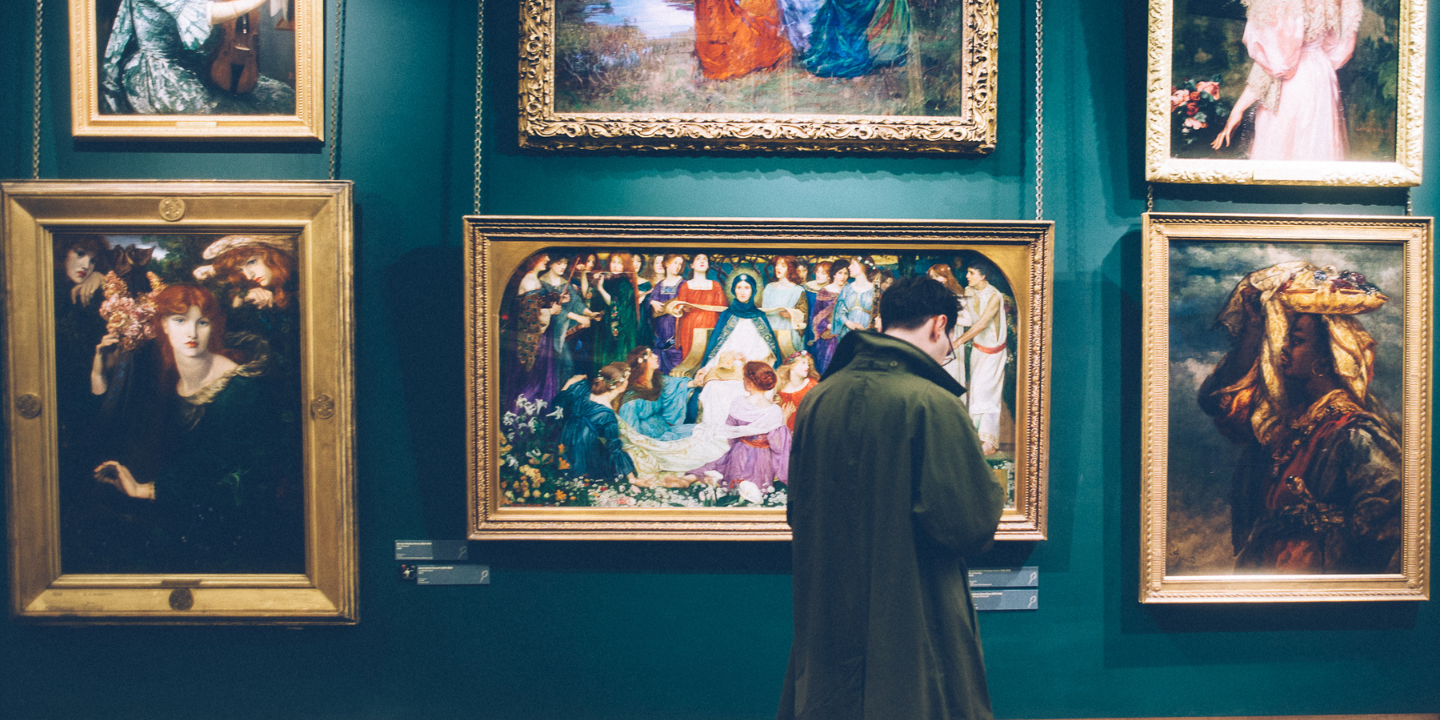Have you ever strolled through the hushed halls of an art gallery, admiring the inspiring works that grace the walls, and wondered, ‘How can my art find its space among these masterpieces?’ Unlocking the doors of opportunity doesn’t have to be a feat fit for Houdini. Whether you’re a painter with palettes rainbow-streaked, a sculptor whose fingers dance with clay, or a photographer capturing whispers of light, it’s your time to shine. Through this mosaic of guidance—the canvas that will narrate the strokes you need to take—I aim to lead you, brush in hand, through the step-by-step journey of showcasing your talent on gallery walls. Put on your creative cap and get ready to transform silent aspirations into loud exhibitions of your art.
Understanding the Art Gallery Landscape
Ever peeked through the glowing glass of an art gallery and seen a world where your creativity could feel at home? Before you can join the ranks of those illustrious halls, it’s crucial to decipher the landscape where your art may soon reside. Like visiting a new city, you’ve got to learn the lay of the land. We’re talking cool contemporary spaces, traditional havens of heritage, and everything in between—each with its own vibe and visitor. Dive in to discover the place where your art can sing its visual melody the loudest. We’ll sift through the types of venues, learn how to spot that just-right gallery, and start making friends with the folks who hold the keys—curators. It’s the first splash of color on your path to thriving in the world of galleries.
I recommend taking a 3D tour
Types of Art Galleries: Knowing Your Venues
Ever feel like a kid in a candy store when you enter an art scene, each gallery with its own flavor of creativity? Well, stepping into the art world is just like that! There are different types of galleries, each with a vibe and audience that could make a perfect home for your work.
For starters, think of commercial galleries. They’re like the high-end boutiques of art, offering collector-worthy pieces and spreading artists’ names in the market. On the other hand, we’ve got cooperative galleries. Imagine a club where artists themselves run the show, often with more room for avant-garde pieces. There are also non-profit galleries and art centers; think of these as community heroes that often support local artists and education. Then we grin at the thought of vanity galleries—sure, they’ll showcase your work, but your wallet’s the guest of honor here.
Remember, each type of gallery could be a new chapter in your art story. It’s all about finding which one fits your style and watching your dreams hang on those walls.
Research Criteria for Perfect Gallery Match
Finding the right place to showcase your creative work is a bit like matchmaking. You want a gallery that not only falls head over heels for your art but also puts it in the limelight. Start with location—do you dream of local fame or are you gunning for international acclaim? This decides whether you look for galleries nearby or spread your wings to art capitals.
Consider the gallery’s style, too. Are your pieces bold and contemporary? Or perhaps, timelessly traditional? Make sure your style complements the gallery’s aesthetic. Ask yourself, does this space tell a similar story to the narratives my works hold within their frames? Don’t be shy to dig deep: explore their past exhibitions, find out which artists they’ve promoted, and the types of crowds they attract. By doing your homework, you’ll find a gallery that resonates with your artistic vision and audience.

Cultivating Relationships with Gallery Curators
Getting to know gallery curators can be the game-changer in showcasing your art. These are the folks who breathe life into exhibitions, deciding what gets wall space and what doesn’t. Start by attending art events and engaging in conversations. When you meet a curator, talk about your creative process and inspirations. Be genuine, not pushy; it’s about forming a connection, not just making a transaction.
Remember, being memorable for your gracious manner is as important as being recognized for your art. Follow up with a polite email, expressing gratitude for their time and any advice they offered. Maybe even invite them to your studio for a personal peek at your work. This personal approach shows dedication and respect for their role in the art community. It helps lay the foundation for a relationship built on mutual appreciation and professional respect.
Curating Your Collection
Have you ever looked at your own art and felt it deserved more than just a spot on your studio wall? It’s time to curate a collection that showcases your unique vision. This crucial step is about more than just selecting pieces; it’s a chance to tell your story and connect with onlookers on a deeper level. From choosing artworks that resonate with your soul to weaving narratives that captivate hearts, we’ll guide you toward a presentation that can stop gallery-goers right in their tracks. Let’s venture into the art of curating your path to a gallery exhibit.
Choosing Works That Speak Your Vision
Cherry-picking the right pieces for a gallery showing is sort of like assembling a greatest hits album—it’s a golden chance to showcase your creativity and passion. Think of each artwork as a chapter of your story; you want visitors to grasp your journey and perspective. Go for variety, but make sure there’s a thread tying your collection together, whether it’s a theme, style, or subject matter that’s undeniably you.
Your artistic vision is your signature, etched into every stroke, sculpt, or shot. Imagine your pieces sparking conversations, evoking emotions, and pulling viewers into your world. This is not just about displaying your technical skills, but also about sharing the stories that fueled your work. After all, art that speaks to you will certainly speak to others.
Stories Behind the Art: Attach Narratives
Imagine walking through a gallery and finding a painting that just looks like splashes of paint. Now picture the same scene, but this time, there’s a little card next to it that tells a captivating tale of what inspired those splashes. Suddenly, it’s not just a painting—it’s a story, an emotion, an experience. That’s the power of attaching narratives to your art.
Every brushstroke has a purpose, and every sculpture holds a whisper of the artist’s journey. By sharing the inspiration and meaning behind each piece, you create a connection with your audience. It’s like offering a personal tour of your imagination. Whether it’s the passion that fueled a midnight oil painting session or the bittersweet memory that a photograph captures, stories help your audience see beyond the canvas. So before you place your art on display, take the time to pen down these stories. They can turn admirers into true fans.
Presentation Tips: Framing and Display
Choosing the Right Frame
When it comes to setting the stage for your creations, selecting the ideal frame is like picking out the perfect outfit for a grand event. Frames not only introduce your masterpiece to viewers but also protect and elevate its status from a mere picture to a conversation starter. Opt for a frame that complements the colors and mood of your work without overpowering it. If your canvas whispers simplicity, a minimalist frame might do the trick; for a piece that screams extravagance, something more ornate can amplify its voice.
The Art of Display
How your art is displayed can be just as crucial as the art itself. Gallery walls are not just backdrops but partners in crime to your art’s storyline. Ensure adequate lighting that caresses each stroke and shadow, showing off every detail. Height is key—hang your pieces at eye level, where the viewer can comfortably dive into your world without strain. Remember, consistency is golden. Maintaining a unified hanging height creates a sense of harmony and professionalism, inviting onlookers to drift seamlessly from one piece to the next.
Creating an Impeccable Portfolio
Let’s talk about crafting your ultimate showpiece: an impeccable portfolio. This is more than a simple collection of your work; it’s the ticket to turning heads and opening doors in the art community. Your portfolio is a sleek reflection of your artistic journey, showcasing your skills, style, and storytelling ability. It’s the visual storybook that captures the essence of your creativity, a curated experience that speaks volumes to those with the power to display it. Let’s dive into this vital art tool, ensuring your portfolio not only sparkles but speaks the language of gallery curators far and wide.
Designing a Professional Artist’s Portfolio
Your artist’s portfolio is like a treasure chest showcasing your jewels of creativity. It’s your visual resume that can captivate the eyes of gallery curators. Start with a clean, well-organized layout that is easy to navigate. Aim for a selection that represents your best work; these pieces should demonstrate both your skill and your unique artistic voice. It’s crucial that each artwork shines on its own while the collection as a whole tells a cohesive story about who you are as an artist.
Choose pieces that highlight your range and versatility, but remember, consistency is key. You’ll also want to include professional photos of your artwork. Ensure these images are high-resolution and in focus to truly do your art justice. If writing isn’t your forte, consider hiring a professional to craft compelling descriptions to accompany each piece. Your words should provide insight into your inspirations and the techniques you poured into each creation. This portfolio is your foot in the gallery door – make it count!
Photography and Reproduction: Capturing the True Essence
Capturing your artwork’s soul through photography isn’t just about snapping a quick pic with your phone. It’s a craft in itself, designed to translate your art’s aesthetics, textures, and emotions into a still image. Professional photography is critical because it serves as the visual handshake between your art and the gallery curators, potential buyers, or the curious eyes scouring the internet. A high-resolution image can highlight the brushwork, the play of light and shadow, or the intricate details that make your work breathe.
When reproducing your masterpieces, the mantra is quality, quality, quality! Think high-fidelity reproductions that sing true to your original vision. This might mean investing in a professional service or learning the ropes of lighting and camera settings yourself. Don’t forget the power of editing software; it can help adjust contrasts and colors to ensure the final print is as close to the original as can be. Remember, when your art is showcased, these photos might just be the deciding factor in securing that spotlight on gallery walls.
Writing an Artist Statement and Bio: Telling Your Tale
When it’s time to pull back the curtain on your creativity, a well-crafted artist statement and bio are like the opening lines of your very own art story. Your artist statement serves as a personal reflection that paints a picture of your work’s essence. Think of it as a window through which others can view the soul of your artistry—the themes you explore, your inspiration, and the unique techniques you employ. It’s not just about what you create, but why and how you bring your visions to life.
Crafting an engaging bio, meanwhile, lets you sketch the contours of your artistic journey. It’s the narrative path through your experiences, milestones, and the evolution of your style. Here, authenticity is key. Share highlights like your education, exhibitions, awards, and any other brushstrokes that add depth to your profile as an artist. Keeping your bio concise yet informative invites gallery curators and art lovers alike to step into your creative world, setting the stage for your masterpieces to do the talking.
Networking, Promoting, and Making Your Mark
In the vibrant world of art, creating masterpieces is just the beginning. Next comes the challenge of showcasing your work and etching your name into the minds of admirers and professionals alike. This stage is all about building bridges—connecting with people, spreading the word, and making sure your art isn’t just seen, but also remembered. It’s time to dive into the art of networking, harness the power of promotion, and carve out a distinct identity that will turn heads and captivate hearts in the art community.
Utilizing Social Media as a Digital Gallery
Ever think of Facebook, Instagram, or Twitter as your personal art show? These platforms are like mini-galleries in the pockets of millions. Showcase your creations by posting high-resolution images of your artwork. It’s like having a 24/7 exhibition, open to anyone, anywhere at any time. Make sure your art pops on the screen to grab those scrolling thumbs.
These digital stages are perfect for telling the story behind each piece. Viewers love to learn about the inspiration and the sweat that goes into a work of art. Don’t forget to engage with your followers! Answer comments, thank them for support, and even ask for feedback. It’s like mingling at an opening night, but with a much larger crowd.
The Power of Art Shows and Community Events
Exhibiting your creations at local art shows and community events can be a stepping stone into the world of galleries. These venues offer a direct line to the public, providing valuable feedback and the chance to weave your identity into the fabric of the local art scene. The exposure you gain is precious, allowing your work to be seen and appreciated by a diverse audience that might include gallery owners, art lovers, and potential buyers.
Art festivals and community gatherings are more than just a place to sell art; they’re networking goldmines. At these lively events, you can meet kindred spirits and industry professionals who provide insights and opportunities that can propel your journey forward. Make sure you’re ready to shine; have your business cards handy, a friendly pitch polished, and your most compelling work on display. This is where whispers of talent become shouts of recognition.
Connecting with Fellow Artists and Art Collectors
As you venture through the art community, it’s vital to weave a strong network with peers and those who have a keen eye for art. Establishing connections is more than just handshakes and exchanging business cards; it involves creating meaningful relationships that could lead to potential collaborations, shared opportunities, or even collectors interested in your work. Engagement is key—participate in art forums, attend gallery openings, and be genuinely curious about others’ work.
To truly sparkle in the social mosaic, consider the following actions:
- Engage on Social Media: Like, comment, and share fellow artists’ works. It’s a wonderful form of support and amplifies your visibility within the community.
- Collaborate on Projects: Working together with other artists can introduce you to new techniques, ideas, and audiences.
- Visit Art Fairs: Immersing yourself in environments where artists and collectors converge can lead to lasting connections.
- Follow Up: If someone shows interest in your work, don’t hesitate to reach out with a thank-you note or an invitation to your next event. Personal touches go a long way.
Remember, every interaction can be the brushstroke that leads to your next opportunity.
Sealing the Deal: Approaching Galleries and Negotiations
In the quest of turning a silent studio into a bustling gallery, knowing the art of the approach can make or break your big break. This chapter of your artist’s journey reads like a classic tale of determination meeting opportunity; it’s where you draw from the well of courage, blend in a dash of marketing savvy, and script out your pathway to the spotlight. Let’s sketch out those crucial moves that convert ‘maybe’ into ‘yes’, etching your name not just on contracts, but in the minds of those who curate creativity.
Crafting a Convincing Pitch and Proposal
When you’re eager to see your creations on the prestigious walls of an art gallery, a well-crafted pitch can open doors that seemed locked tight. Think of your pitch as a handshake, the first impression that can either welcome you in or turn you away. Your pitch should ooze with the uniqueness of your work, making clear why a gallery should invest wall space in your art. It’s crucial to tailor your proposal to each gallery’s specific interests and style; a one-size-fits-all approach simply won’t cut it.
In your proposal, go beyond just the visuals. Illuminate the tales that each piece tells, the emotions they stir, and the conversations they ignite. Remember to include high-quality images of your work, a succinct and vibrant description of your collection, and the themes that thread your pieces together. Your proposal isn’t just a request for space—it’s an invitation to embark on a journey through your artistic landscape. Be bold, be vivid, and most importantly, be irresistibly persuasive.
Understanding Galleries’ Contracts and Terms
Ever wondered what happens after the handshake and the celebratory toasts? You’re about to enter into a partnership, and that means paperwork – but don’t let it scare you. Navigating the formalities can be as smooth as a painter’s brushstroke with a little know-how.
Legal jargon seems daunting, but it’s key to ensuring you and the gallery have a shared vision for your art’s future. To prevent any surprises, carefully read through the entire contract. Pay special attention to commission rates, which can vary, but commonly range from 30% to 50%. It’s the gallery’s cut for showcasing your work and helping you sell it. The contract will also outline the length of the exhibition, shipping responsibilities, insurance details, and pricing control.
Don’t just sign on the dotted line without understanding every clause. If something feels off, ask questions or seek advice from a legal eye. Remember, the goal is a beneficial relationship for both you and the gallery, so clarity and mutual agreement are the order of the day.
Galvanize the No’s into Stepping Stones
When facing rejection, remember it’s not the end of the road but rather a detour to a path of growth. It’s natural to feel deflated when a gallery turns you down, yet those “no’s” can become the stepping stones paving your way to success. Treat every rejection as a lesson, and use it to polish your approach. Ask for feedback, and listen carefully to the reasons given; adjust your collection, presentation, or pitch accordingly. Through perseverance and resilience, what once seemed like barriers will transform into valuable opportunities to learn and evolve.
Take a stand against discouragement by rekindling your creative fires with each setback. The world’s most celebrated artists weren’t strangers to rejection—many experienced it frequently. But they didn’t let that dissuade them. They embraced these challenges, refining their art and their approach, until the right doors swung open. Your next big break could be one more try away, so let each no fuel your drive to find the yes that awaits.
Maintaining the Relationship with Your Gallery
Securing a spot on the gallery walls is just the commencement of a dynamic voyage in the art world. The key to truly blossom as an artist isn’t only about that initial handshake. It lies within nurturing the bonds you form with the gallery team. This ongoing partnership can lift your work to new heights and unfurl opportunities like a canvas awaiting the first brushstroke. Engage persistently, listen intently, and evolve constantly; these are the pillars to ensure your creations keep a home amidst a gallery’s ever-changing landscape.
Open Communication: The Artist-Gallery Partnership
Once your art finds its home on gallery walls, maintaining that relationship is key. Think of it as a partnership: the gallery showcases your work, and you bring your unique flair and audience. It’s a mutual dance where each step should be in harmony.
You’ve got to keep the conversation going. Share your creative process, upcoming projects, and even the challenges you face—it shows you’re invested. And when they lend insight to trends and feedback, listen up. By getting to know the team and understanding their viewpoint, you’re not just another artist; you become a part of the gallery’s vibrant tapestry.
Attendance and Engagement: Becoming a Gallery Regular
Regularly showing up at galleries isn’t just about creating visibility for your work; it’s also about immersing yourself in the artistic community. By attending various exhibitions and events, you’re not only supporting fellow artists, but also learning what resonates with gallery visitors. This knowledge is invaluable when preparing your own showings.
Staying engaged with the gallery scene lets people know you’re serious about your craft. It opens doors for conversation with curators, artists, and art collectors. Networking in person can lead to beneficial relationships and future opportunities. So, mark your calendar, dress to impress with your artistically unique flair, and be ready to mingle with the art-savvy crowd.
Expanding Your Horizons: Continuous Learning and Exhibiting
Once your creations have found a home on gallery walls, the journey is far from over. Continuous learning is the heartbeat of any thriving artistic career. Stay inquisitive and invest time in honing your skills, whether through formal workshops, online courses, or by experimenting with new techniques and mediums.
Just as important is the commitment to exhibiting regularly. Each show is not just a space to display work; it’s an opportunity to touch a new audience, to stir emotions, and to weave your narrative into the cultural tapestry. Keep an eye out for calls for art, and don’t shy away from group or themed exhibitions; they can be gateways to new avenues of inspiration and growth.
Conclusion
The journey from artist to exhibitor is lined with vibrant expectations and sometimes unexpected turns. On this enlightening trek to fit your key into the art world’s waiting lock, patience and persistence are your eternal allies. Connecting your artistic roots to the sprawling branches of galleries might feel like a journey across continents but remember—it begins with a single step. Stepping through that gallery door with your artwork cradled in your arms, inspiring awe in viewers, and sharing your personal intricacies upon those walls is just beyond this mapped adventure. So, march forward with these beacons of insight along your palette-streaked path to success, making a resounding name for yourself where ‘how to get your art in a gallery’ shifts to ‘when my art illuminated a gallery.’




